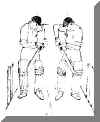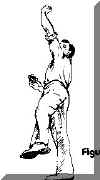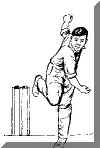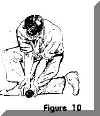|
BATTING The following will apply
to a right handed batsman
The Grip (Fig. 1)  Rest
the bat handle on your left knee with the face of the bat downwards. Place
the hands above the handle with palms facing downwards. Move hands towards
the ground and meet the handle with the palms, closing hands round the
handle. Rest
the bat handle on your left knee with the face of the bat downwards. Place
the hands above the handle with palms facing downwards. Move hands towards
the ground and meet the handle with the palms, closing hands round the
handle.
Helpful Hints 1. Check right hand above left 2. Both hands are
close together 3. 'V of left hand above V' of right hand
The Stance (Fig 2)  Place
feet either side of, and parallel to, the crease The left side of the
batsman points towards the bowler. Bend the knees slightly to allow for
easy movement. Keep the head upright and the eyes level. Place
feet either side of, and parallel to, the crease The left side of the
batsman points towards the bowler. Bend the knees slightly to allow for
easy movement. Keep the head upright and the eyes level.
Helpful Hints I Feet comfortably, but not too far apart 2 Bat rests
behind back right foot 3 Left shoulder towards bowler. 4. Head turned to
face bowler with eyes level
The Back Lift As the bowler is about to deliver the
ball, push the bat back towards the stumps with the left arm and hand.
Open the face of the bat at the top of the back lift with the wrists. It
is important to remember that the back lift need not be very high, ie.
just above stump level, but must be straight to ensure a straight follow
through.
Taking Guard · Ask for a guard that allows you to
look down the wicket from middle stump to middle stump, with the eyes
level (see 'The Stance). · When batting in a match, always talk to the
other batsman at the end of each over to see how the game is progressing
and to help each other to concentrate.
Basic Shots
Forward Defensive PLAYED TO A BALL PITCHED UP TO THE
BATSMAN BUT NOT QUITE A HALF VOLLEY, IN FACT A GOOD LENGTH BALL.
The left foot moves as close to the pitch of the ball as possible. The
left shoulder and left elbow lead the bat towards the ball. Bend the left
knee so that the head is over the ball as the bat plays the ball into the
ground in front of you.
Drives
 (Fig. 3) THE STRAIGHT DRIVE IS PLAYED TO A HALF-VOLLEY,
OR FULL TOSS PITCHING ON, OR JUST OUTSIDE THE OFF STUMP. This is iust an
extension of the forward defensive shot. Left foot steps to the pitch of
the ball. Lead with the head and the left shoulder. The weight is now on
the front (left) foot and the head is over the line of the ball. The left
knee is bent to hit the ball along the ground. The full face of the bat
goes through the ball. The bat finishes up pointing to where the ball has
to be hit.
(Fig. 3) THE STRAIGHT DRIVE IS PLAYED TO A HALF-VOLLEY,
OR FULL TOSS PITCHING ON, OR JUST OUTSIDE THE OFF STUMP. This is iust an
extension of the forward defensive shot. Left foot steps to the pitch of
the ball. Lead with the head and the left shoulder. The weight is now on
the front (left) foot and the head is over the line of the ball. The left
knee is bent to hit the ball along the ground. The full face of the bat
goes through the ball. The bat finishes up pointing to where the ball has
to be hit.
THE COVER DRIVE IS PLAYED TO A HALF VOLLEY THAT
PITCHES WIDER OF THE OFF STUMP. The left foot is moved further across to
allow the head to be in line with the ball. Lead with the ]eft shoulder
iturn your back towards the bowler) to ensure that the shot is played in a
sideways position. The full face of the bat hits through the ball and
points in the direction that you wish the ball to go.
THE ON DRIVE IS PLAYED TO A HALF VOLLEY THAT PITCHES
ON, OR JUST OUTSIDE, THE LEG STUMP. The left shoulder is dipped and the
left foot has opened to move forward and outside (legside) the line of the
ball. Again, the full face of the bat comes through the ball, which is hit
between mid-on and the bowler.
Helpful Hints 1. Pick bat up straight. 2. Get left foot close to
pitch of ball. 3. Lead with left shoulder. 4. Left hand controls the shot.
5. Full face hits through line of ball. 6. Don't try to hit the ball too
hard as you will overbalance and lose power.
 Backward
Defence (Fig.4) Backward
Defence (Fig.4)
PLAYED TO A SHORT PITCHED STRAIGHT BALL. The right foot moves back
towards the stumps and across so that the head is in line with the ball.
The right foot remains parallel to the crease so that the body stays in a
sideways position. The left elbow points towards the bowler, so that the
left hand controls the shot. The head is directly over the ball on contact
ensuring that the ball goes down.
Helpful Hints 1. Right foot back and across. 2. Head over ball. 3.
Left elbow high. 4. Ball played inside body.
Figure 4
Backfoot Drive PLAYED TO A SHORT BALL, SLIGHTLY WIDE
OF THE OFF STUMP. This again, is an extension of the defensive stroke. The
back lift is higher and the bat comes through more quickly. The weight of
the body is transferred forward into the stroke. The right hand punches
the ball to give more power. The head is still kept in line. The left arm
still controls the shot and the full face of the bat hits through the ball
in the intended direction of the shot.
Hitting to Leg.
1. THE FULL TOSS -- ON OR OUTSIDE BATSMAN'S PADS (Fig. 5) The head is
moved towards and over the line of the ball -- and kept still. The left
foot moves forward pointing straight down the pitch. The left knee is bent
so that body weight is forward. The bat comes across the line of the ball
in a full swing to meet the ball in front of the left leg.
2. THE LONG HOP -- SHORT PITCHED BALL GOING DOWN THE LEG SIDE (Fig. 6)
Move the right foot back and across but pointing towards the bowler. Bring
the left foot back so that they are I/2 metre apart, and also pointing
towards the bowler. The head should now be in line with the ball. The body
weight is towards the bowler. Swing the bat across the line of the ball,
and turn your wrists over on contact with the ball to hit it down.
Helpful Hints (For both shots) 1. Watch ball onto bat (keep head in
line). 2. Allow full swing of bat in front of body. 3. Aim to hit ball in
front of square leg. 4. Do not try to hit ball too hard as you will
overbalance and lose control and power.
Cut Off the Back Foot (Fig. 7)
 PLAYED
TO A SHORT PITCHED BALL WIDE OF THE OFF STUMP. The right foot moves back
and across, bringing the head in line with the ball. The right toe points
in the direction of the intended stroke. Bring the bat down and over the
ball GUIDING it square of the wicket. Turn the wrists on contact to ensure
the ball goes down. PLAYED
TO A SHORT PITCHED BALL WIDE OF THE OFF STUMP. The right foot moves back
and across, bringing the head in line with the ball. The right toe points
in the direction of the intended stroke. Bring the bat down and over the
ball GUIDING it square of the wicket. Turn the wrists on contact to ensure
the ball goes down.

Helpful Hints 1. Make sure bat is high enough to get on top of the
ball. 2. Do not try to cut too hard, or you may get under the ball. 3. Use
the pace of the ball and try not to hit too early.
BOWLING The fundamentals of good
bowling are:
1. A correct grip. 2. A smooth, economical run-up. 3. An easy,
rhythmical and well balanced delivery, making full use of your height and
body. 4. A deliberate and fluent follow through.
The Grip The grip varies according to the type of
delivery, but for all types of the ball is held in the fingers and not the
palm.
 The
Run Up The run up should start slowly, gradually increase speed,
and over the strides, full pace should be reached. The
Run Up The run up should start slowly, gradually increase speed,
and over the strides, full pace should be reached.
The Delivery The last stride, a jump off the left foot
turning the body sideways and the left arm stretching upwards. The right
foot lands behind and parallel to the crease. The body turns so that the
left shoulder points towards batsman. The left arm extends upward, and the
bowler looks at the batsman over his left shoulder. The weight is on the
right foot and the body is leaning away from the batsman. The left foot
lands in front of the right foot pointing to long leg, to ensure a
sideways position. Keep left arm pointing towards batsman. Transfer body
weight onto left leg. Allow left arm to come through, across and then
behind the body. Bring the right arm over, as high and as straight as
possible, letting go of the ball. The right arm then continues past the
left thigh. The eyes are looking down the pitch and the head is still. The
follow through continues taking the bowler to the off side and off the
wicket.
Helpful Hints 1. Run up must be consistent and gradual.  2.
Land with the right foot parallel to crease. 3. Look down wicket from
behind left shoulder. 4. Keep left shoulder pointing down wicket for as
long as possible. 5. Keep left leg braced (do not let it collapse). 6. Get
right arm high on delivery. 7. Follow through. 8. Concentrate eyes and
mind on the spot where ball is meant to drop. 2.
Land with the right foot parallel to crease. 3. Look down wicket from
behind left shoulder. 4. Keep left shoulder pointing down wicket for as
long as possible. 5. Keep left leg braced (do not let it collapse). 6. Get
right arm high on delivery. 7. Follow through. 8. Concentrate eyes and
mind on the spot where ball is meant to drop.
There are too many different methods of bowling to discuss in detail
here, but by following the basic steps, success can be obtained whatever
the type of bowler.
The aim of any bowler is to defeat the opposing batsman and to do this,
he must be able to command accuracy in length and direction.
This can only be acquired by will power and practice.
FIELDING Fielding is very
important in the modern game and should be fun, even more so if everyone
tries. The fielder's first job is to stop the ball and there are two
methods of defensive fielding.
The Orthodox Position Get in line with the ball early.
Form a 'V' with the heels touching when facing the ball. Bend the knees
and keep the head above your hands. Point the fingers down and stop the
ball in front of your feet. The following will apply to right handed
throwers
 The
Long Barrier Position (Fig. 1O) Get into the line of the ball as
quickly as possible. Turn sideways to the line of the ball. Drop onto the
left knee, so that the knee overlaps, with right foot. (Lower left leg and
right foot form a barrier to act as second line of defence). Head is above
the hands, with fingers pointing. down, when the ball is stopped. The
Long Barrier Position (Fig. 1O) Get into the line of the ball as
quickly as possible. Turn sideways to the line of the ball. Drop onto the
left knee, so that the knee overlaps, with right foot. (Lower left leg and
right foot form a barrier to act as second line of defence). Head is above
the hands, with fingers pointing. down, when the ball is stopped.
Offensive Fielding This method allows the throw-in to
follow picking up the ball, almost immediately; in fact becomes the last
part of the one action and could result in running the batsman out. Move
onto and towards the line of the ball early. Get sideways to the line of
the ball. Bend both hips and knees. The right foot is at right angles to
the line of the ball at the moment of stopping. The head is over the
hands; fingers pointing down, which are just in front of the right foot.
Once the ball is fully under control, point the left arm in the direction
of the throw, take the right arm back and throw to your team-mate, aiming
for his chest.
Catching Catches are vital in that they could win or
lose a match. When catching, do not move until you have seen the ball.
Move quickly then to the line of the ball. Keep the head still and watch
the ball all the way. Make a wide 'web' with the hands, interlocking the
little fingers. For high catches, try to catch at eye-level. For catches
below chest level, point fingers down. When fielding, all fielders apart
from the first slip and leg slip, will watch the batsman. Close catchers,
such as slips and gully, remain crouched and still, with hands ready to
catch. Outfielders, such as mid-off, square leg and third man, walk in as
the bowler runs in. All fielders will expect the ball to come to them.
BE BALANCED, RELAXED and EXPECTANT.
WICKET-KEEPING
Of all the positions in the field, the wicket-keeper is the most
important and the most demanding. A wicket keeper should make sure that
his stance: 1. Is comfortable and not strained. 2. Allows him the best
possible sight of the ball. 3. Enables him to take the ball with the
minimum of movement. 4. Is close enough to the wicket, so that he can
stump the batsman without having to reach for the stumps.
The following feet movements allow wicket keepers to take balls on the
offside and down the legside whilst keeping the body facing and close to
the stumps.

Helpful Hints 1. The body and head must be kept still. 2. Stay down
for as long as possible, only rising to meet the rise of the ball off the
pitch. 3. The feet should move as little as possible, just making sure
that the body is behind the ball. 4. Always take the ball with the fingers
pointing down, never at the ball. 5. When catching, 'give' slightly with
the ball. (Never move the hands towards the ball or snatch at it!
CAPTAINCY Of all sports, the
cricket captain's task is the most demanding. It can also be the most
rewarding. For every cricketer, knowledge of every fielding position
should be studied. As the captain's job is so demanding requiring bowling
changes and fielding changes, it is up to the other nine players to help
him by remembering their fielding positions and keeping an eye on the
captain if he wants to move them during an over.
GENERAL TIPS
EQUIPMENT
The size of bats are always a problem. Don't buy the best bat on the
market. That may not be the correct size for you. A fair guideline of size
of bat is that is that the bat should not reach higher than the boy's hip
bone when held against his leg. For a very keen junior cricketer, it is
always good for him to have his own equipment. It makes nice Christmas and
birthday presents. Bat, batting gloves, pads and box are necessary. Always
be prepared for a long hot day with drinks and zinc cream for the face.
White clothing for match day is very important. Looking the part on the
field is half the battle of becoming a good cricketer. So boys, lets look
the part by wearing the proper gear.
RUNNING BETWEEN THE WICKETS ·
There are three basic calls to use: YES, NO and WAIT, followed by YES or
NO. · Try and call as early and as clearly as possible. · When the ball
goes behind the wicket at which the batsman is playing, the non-striking
batsman (one at bowler's end) calls for the run. All other calls should be
made by the batsman facing the bowler. · When there is a chance of taking
more than one run, always run facing the side of the field where the ball
is, even if it means changing the bat into your other hand. Never turn to
run when you cannot see where the ball is.
Finally · Never question the umpire's decision. · DO NOT USE bad
language on the field. · Cheer and encourage the members of your team
always. Never use discouraging words. · Learn to enjoy the game and make
it enjoyable for others.
|
